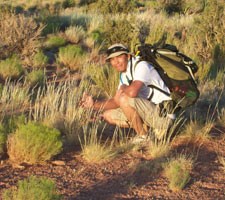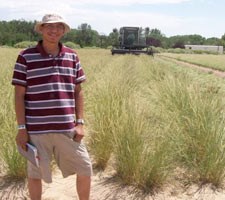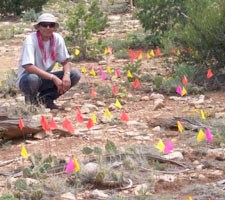Native Plants Student Intern from Northern Arizona University Assists Vegetation Programby Allyson Mathis photos courtesy of Deon Ben In 2008, Northern Arizona University (NAU) student Deon Ben interned with Grand Canyon National Park’s Division of Science and Resource Management’s Vegetation Program. Ben, a Diné (Navajo) senior in environmental studies from Tohatchi, NM, spent the summer months living and working at Grand Canyon National Park as NAU’s first Native Plant and Seed Program Intern at the park. 
Martha Hahn, Chief of Science and Resource Management at Grand Canyon National Park, explained, “The goal of this partnership is to bring together young scholars and scientific expertise from the university to help meet park management challenges. EMA’s goal of advancing land stewardship in the Southwest perfectly meshes with NPS mandates and this partnership is an effective way to meet park resource preservation needs in the 21st century.” Other partners in the project include the NAU Foundation and Grand Canyon Association, the park’s cooperating association. 
Ben’s primary responsibility was to collect seeds from native plants in Grand Canyon National Park. He collected seeds from 20 plant species and from 32 species of native forbs, shrubs or trees from locations throughout the park on both the South Rim and the North Rim. Ben worked under the supervision of Grand Canyon National Park horticulturalist Jan Busco and EMA Senior Research Program Coordinator Janet Lynn. Ben was also able to use his internship as his environmental studies capstone project, which provides graduating seniors with professional occupational skills through internships or independent projects. Busco said, “Deon’s seed internship has allowed the park to expand our seed collection program. Some of the seeds Deon collected will help us learn which species grow well planted from seed after fire or invasive plant removal.” 
Ben’s internship also supported the work of the Northern Arizona Native Seed Alliance (NANSA) that was formed in March 2007 to support the availability of genetically diverse native plant materials for conservation and restoration projects in northern Arizona. Partners in NANSA include governmental agencies, such as the National Park Service, nongovernmental conservation organizations, commercial businesses, private landowners, and individuals. “Deon’s participation with NANSA provided an opportunity to better understand the importance of his work at the Grand Canyon and its contribution to the broader goals of the region,” said Janet Lynn, who is also the coordinator for NANSA. “It also illustrated the National Park Service’s commitment to the program and to working through a collaborative process to find solutions to regional conservation issues.” 

Of Ben’s contributions to the park, Hahn said, “He did a great job bringing all the information together, figuring out the volume of seeds that we need, where to collect them, and how we would propagate them.” Ben’s internship ended at the conclusion of the fall semester in 2008. As his project neared completion he presented the results of his work to Science and Resource Management staff, and to NAU students and faculty at the Grand Canyon Science and Resource Management Open House on the NAU campus in November. Ben plans to graduate in May 2009, and hopes to pursue a career in environmental restoration on the Colorado Plateau, perhaps on the Navajo reservation, specializing in air quality or water management. About his experience as the Native Plant and Seed Intern, Ben said, “I would like to thank each individual and organization that allowed me to experience this once in a life time opportunity. I am truly grateful and ecstatic about the handful of knowledge I received throughout my internship. This experience truly will guide me through my future endeavors. Ahe’hee.” (Dearly Grateful in Navajo.) Learn more about NAU’s Ecological Monitoring & Assessment ProgramReturn to Canyon Sketches eMagazine Home Page |
Last updated: April 30, 2023
